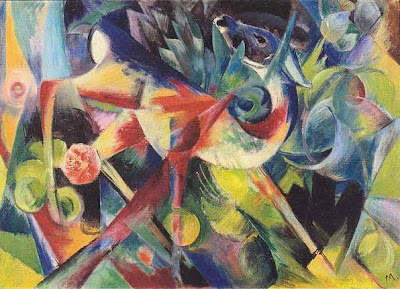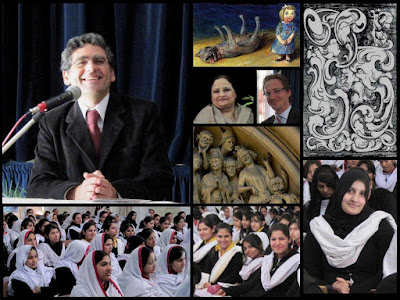The much expected lecture "Looking at Pictures and Learning from Art" was given today at the Islamabad College for Girls, where lecturer Mariano Akerman met the unprecedented number of 400 Pakistani students.
"Looking at Pictures and Learning from Art" is part of Shape and Meaning, a program of educational lectures on the German contribution to the visual arts. Aiming to bridge cultures and people, the program counts with the generous support of the German Embassy in Islamabad.

Mariano Akerman explored and discussed artworks and masterpieces by forerunners of German imagery, including Albrech Dürer, Balthasar Küchler, Christoph Jamnitzer, Johann Esaias Nilson, Max Liebermann, Lesser Ury, Ludwig Meidner, Karl Schmidt-Rothluff, Franz Marc, and Max Ernst.
The event took place at the Islamabad College for Girls and was kindly organized by Prof. Rabya Qadir, who gathered an incredible number of students and teachers from her Institution and from four other neighbor educational centers among which the Imperial International School F10/3, the Federal Government School for Girls G6/1-3; the Federal Government Junior Girls Model School G6/3; and the Federal Goverment Boys Secondary School No.8 F6/2.
"Looking at Pictures and Learning from Art" is part of Shape and Meaning, a program of educational lectures on the German contribution to the visual arts. Aiming to bridge cultures and people, the program counts with the generous support of the German Embassy in Islamabad.

Mariano Akerman explored and discussed artworks and masterpieces by forerunners of German imagery, including Albrech Dürer, Balthasar Küchler, Christoph Jamnitzer, Johann Esaias Nilson, Max Liebermann, Lesser Ury, Ludwig Meidner, Karl Schmidt-Rothluff, Franz Marc, and Max Ernst.

Dürer, The Large Turf, watercolor, 1503

Johann Georg Hertel (after Jeremias Wachsmuth), Winter, Rococo Music, Fancy Dress Ball, etching, 1750-60

Max Liebermann, Country Tavern at Brannenburg, oil, 1893

Franz Marc, Deer in Flower Garden, oil, 1913
Students were interested in topics such as the development of the artist as an individual in the 16th century, the various trends dealing with the imagination in the 17th century, the 18th-century notion of artificiality, and the main differences between Impressionism and Expressionism in German Art.

In a memorable gesture, tokens of friendship were given to the representative of the German Embassy and to the lecturer. The meeting was closed with a cup of local tea and a general desire of meeting once again soon.

In a memorable gesture, tokens of friendship were given to the representative of the German Embassy and to the lecturer. The meeting was closed with a cup of local tea and a general desire of meeting once again soon.


Event brochure, November 2010


Shape and Meaning: The German Contribution to the Visual Arts - Five Educational Lectures by Mariano Akerman, German Embassy Islamabad, 3.1.2011, Education & Culture

Deutsche Kunst - Form und Bedeutung. Eine Vorlesungsreihe von Mariano Akerman, Botschaft der Bundesrepublik Deutschland, Islamabad, 3.1.2011, Kulturelle Beziehungen (Andreas Dauth).
Selected masterpieces at the German Art Gallery











































